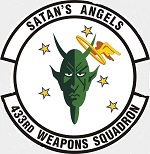Hobby Master HA19070 USAF McDonnell F-4C Phantom II Fighter-Bomber - 63-7499, Daniel "Chappie" James Jr., 433rd Tactical Fighter Squadron "Satan's Angels", 8th Tactical Fighter Wing, Ubon RTAFB, Thailand, 1967 (1:72 Scale)
"The winner [of an air battle] may have been determined by the amount of time, energy, thought and training an individual has previously accomplished in an effort to increase his ability as a fighter pilot."
- Lt. Randy "Duke" Cunningham
 The McDonnell Douglas F-4 Phantom II is a two-seat, twin-engined, all-weather, long-range supersonic fighter-bomber originally developed for the U.S. Navy by McDonnell Aircraft. Proving highly adaptable, it became a major part of the air wings of the U.S. Navy, Marine Corps, and U.S. Air Force. It was used extensively by all three of these services during the Vietnam War, serving as the principal air superiority fighter for both the Navy and Air Force, as well as being important in the ground-attack and reconnaissance roles by the close of U.S. involvement in the war.
The McDonnell Douglas F-4 Phantom II is a two-seat, twin-engined, all-weather, long-range supersonic fighter-bomber originally developed for the U.S. Navy by McDonnell Aircraft. Proving highly adaptable, it became a major part of the air wings of the U.S. Navy, Marine Corps, and U.S. Air Force. It was used extensively by all three of these services during the Vietnam War, serving as the principal air superiority fighter for both the Navy and Air Force, as well as being important in the ground-attack and reconnaissance roles by the close of U.S. involvement in the war.
First entering service in 1960, the Phantom continued to form a major part of U.S. military air power throughout the 1970s and 1980s, being gradually replaced by more modern aircraft such as the F-15 Eagle and F-16 Fighting Falcon in the U.S. Air Force and the F-14 Tomcat and F/A-18 Hornet in the U.S. Navy. It remained in service in the reconnaissance and Wild Weasel roles in the 1991 Gulf War, finally leaving service in 1996. The Phantom was also operated by the armed forces of 11 other nations. Israeli Phantoms saw extensive combat in several Arab - Israeli conflicts, while Iran used its large fleet of Phantoms in the Iran - Iraq War. Phantoms remain in front line service with seven countries, and in use as an unmanned target in the U.S. Air Force.
Phantom production ran from 1958 to 1981, with a total of 5,195 built. This extensive run makes it the second most-produced Western jet fighter, behind the famous F-86 Sabre at just under 10,000 examples.
The F-4 Phantom was designed as a fleet defense fighter for the U.S. Navy, and first entered service in 1960. By 1963, it had been adopted by the U.S. Air Force for the fighter-bomber role. When production ended in 1981, 5,195 Phantom IIs had been built, making it the most numerous American supersonic military aircraft. Until the advent of the F-15 Eagle, the F-4 also held a record for the longest continuous production for a fighter with a run of 24 years. Innovations in the F-4 included an advanced pulse-doppler radar and extensive use of titanium in its airframe.
The RF-4 was an unarmed photographic reconnaissance version of the USAF's F-4C which carried a variety of film-based and side-looking radar [SLAR] sensors for the Air Force [RF-4C] and the Marine Corps [RF-4B].
In February 1963, the Marine Corps agreed to acquire the first 9 of what would eventually amount to a fleet of 46 RF-4Bs, a photographic reconnaissance version of the basic F-4 Phantom. The RF-4B was generally similar to the more numerous Air Force RF-4C, with a lengthened nose designed for reconnaissance applications. Three separate camera bays in the nose were designated Stations 1, 2, and 3, and carried a variety of cameras, which unlike the cameras of the RF-4Cs were on rotating mounts so they could be aimed at targets off the flight path.
Pictured here is a 1:72 scale replica of a USAF McDonnell F-4C Phantom II Fighter-Bomber that was piloted by Daniel "Chappie" James Jr., who was attached to the 433rd Tactical Fighter Squadron "Satan's Angels", 8th Tactical Fighter Wing, then deployed to Ubon RTAFB, Thailand, during 1967.
Pre-order! Ship Date: March 2025.
Dimensions:
Wingspan: 6-1/4-inches
Length: 10-1/2-inches
Release Date: ?
 Historical Account: "Satan's Angels" - The 433rd Tactical Fighter Squadron Was deployed to Ubon Royal Thai Air Force Base in December 1965, becoming part of Pacific Air Forces Thirteenth Air Force. Assigned to the 8th Tactical Fighter Wing, engaged in combat operations over Southeast Asia, the squadron's mission included bombardment, ground support, air defense, interdiction, and armed reconnaissance.
Historical Account: "Satan's Angels" - The 433rd Tactical Fighter Squadron Was deployed to Ubon Royal Thai Air Force Base in December 1965, becoming part of Pacific Air Forces Thirteenth Air Force. Assigned to the 8th Tactical Fighter Wing, engaged in combat operations over Southeast Asia, the squadron's mission included bombardment, ground support, air defense, interdiction, and armed reconnaissance.
Beginning in May 1967, it was re-equipped with new F-4D aircraft. This gave the unit the distinction of being the first in Southeast Asia to be operationally equipped with improved Phantom II. In May 1968, the squadron began combat-testing the first laser-guided bombs (LGBs), the BOLT-117 and the Paveway.
During its final years of combat, used F-4Ds for fast-forward air control, interdiction, escort, armed reconnaissance, and other special missions. Continued combat in Vietnam until mid-January 1973, in Laos until February 22nd, 1973, and in Cambodia until August 15th, 1973. Remained in Thailand until July 1974 when the squadron was inactivated.


